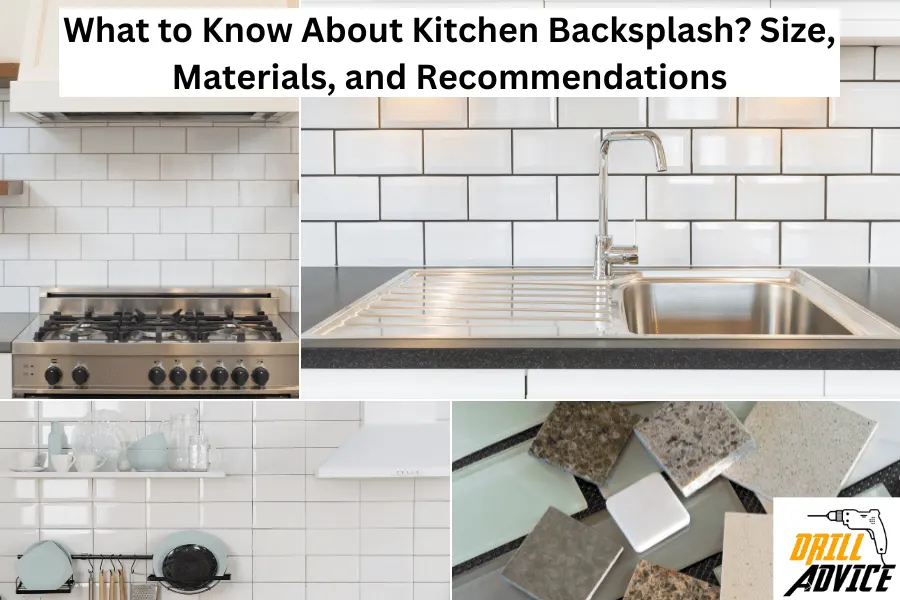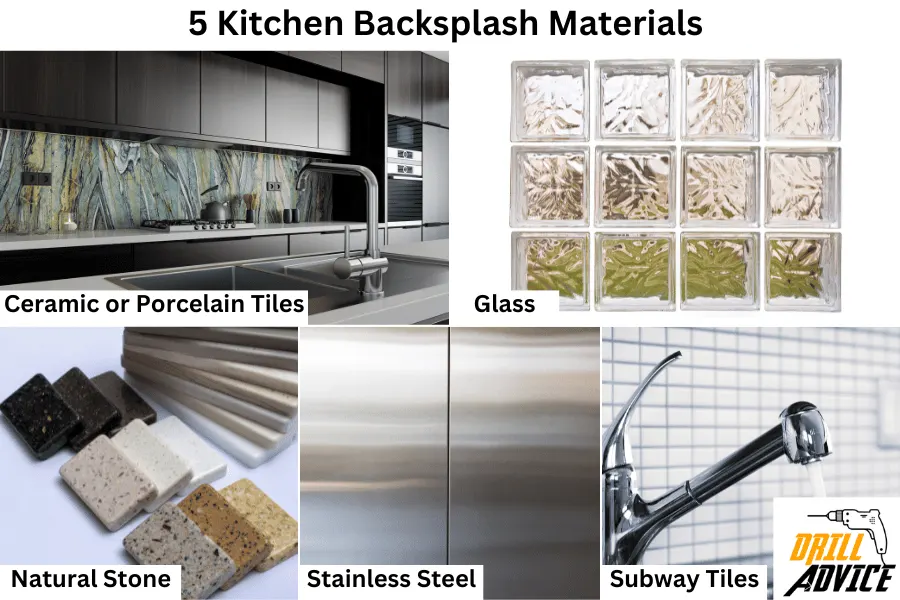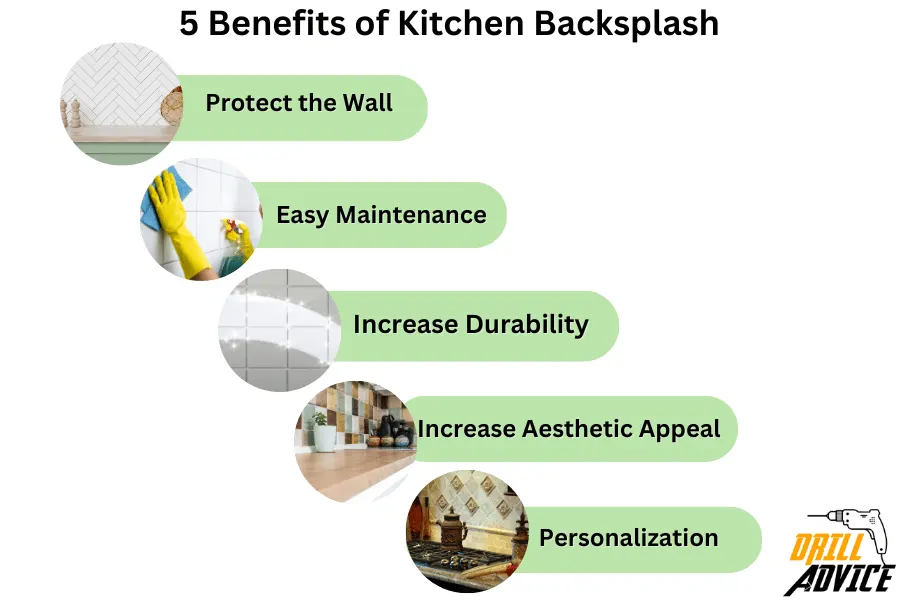
A kitchen backsplash is a protective and decorative material layer installed on the wall behind the stove, sink, or countertop in the kitchen. The recommended width of the backsplash is 15-20 inches, and the length of the backsplash is based on the countertop length. The height of the backsplash is between 18 and 25 inches.
Tiles, glass, natural stones, stainless steel and subway tiles are the most used kitchen backsplash materials. Among them, tiles are the best backsplash material with considering it’s physical characteristics. Before choosing a kitchen backsplash material, you should consider its durability, maintenance, style and aesthetic appeal, budget, and personal choices. When the tile is laid, its grout thickness should be between 1/8 to 1/4 of an inch.
Before you build a kitchen backsplash, you should consider its design style, functionality, budget, maintenance, durability and personnel preferences. When you are building a kitchen backsplash, you have to waterproof the wall if the materials are higher porous and have a higher water absorption rate.
The benefits of the kitchen backsplash are improving wall protection, ease of maintenance, increased durability, increased aesthetic appeal and personalised area as you need.
What is the Kitchen Backsplash?
A kitchen backsplash is a protective and decorative feature installed on the wall behind the stove, sink, or countertop in the kitchen. Its main task is to protect the wall from splatters, stains, and moisture. Additionally, a backsplash adds a visual appeal and a touch of style to the overall kitchen design.
What is the Best Size for the Kitchen Backsplash?
The recommended width for a backsplash is typically between 15 and 20 inches, while the length can vary based on the length of the countertop or area you want to cover. However, it’s important to consider the dimensions of your kitchen and the specific area where you plan to install the backsplash.
In terms of length, the backsplash should ideally extend along the entire length of the countertop or area you want to cover. This ensures seamless coverage and enhances the overall aesthetic appeal of your kitchen. However, if you have limited wall space or prefer a more customized look, you can choose to install a backsplash that only covers a specific section of the wall.
What is the Best Height for the Kitchen Backsplash?
The recommended height for a kitchen backsplash is typically between 18 and 25 inches. This height provides adequate protection for the wall behind the stove, sink, or countertop, ensuring that splatters, stains, and moisture are kept at bay.
However, it’s important to note that the height can be adjusted based on personal preference and the specific needs of your kitchen. If you find that you frequently deal with splatters or have taller appliances or fixtures, you may consider opting for a taller backsplash to provide better coverage and protection.
What is a Full Height Backsplash?
A full-height backsplash is a wall-covering backsplash that extends from the countertop surface up to the bottom of the upper cabinets or sometimes even up to the ceiling. The purpose of a full backsplash is to protect the walls from splashes, spills, and stains that can occur during cooking or cleaning.
While traditional backsplashes may only rise a few inches above the countertop, a full-height backsplash provides a more expansive and often more visually striking backdrop in the kitchen.
What Should Consider Before Choose a Backsplash Material?
The following factors should be considered before we select a material for the kitchen backsplash.
1. Higher Durability – The backsplash material should be able to withstand heat, moisture, and potential splatters. So it’s important to choose a material that is durable and resistant to damage. The durability of the backsplash material helps to maintenance its appearance over time.
2. Less Maintenance – It’s important to consider the level of maintenance required for the chosen material because some materials require regular sealing, while others may be stain-resistant and easy to clean.
3. Stylish and Aesthetics – The backsplash material should be stylish and rich with aesthetic appeal. So it’s important to consider the color scheme, textures, and finishes of the cabinets, countertops, and flooring.
4. Affordable Budget – You should consider the budget for the kitchen backsplash material. Because some materials are expensive and quality some are cheap and low quality. Therefore you should choose a material with higher quality and an affordable budget for the kitchen.
5. Longevity – Think about how long you plan to stay in your current home and choose a backslash according to your preferences.
6. Personal Preference – Always try to choose a backsplash material that you love which reflects your personal style and speaks to your individual preferences.
Read More About
- 12 Best Kitchen Flooring: Durability, Resistance, Maintenance and Budget
- 8 Types of Cooktops: Gas, Electric and Inductions
What Are the 5 Kitchen Backsplash Materials?

1. Ceramic or Porcelain Tiles:
Ceramic or porcelain tiles are popular choices for kitchen backsplashes due to their durability, affordability, and wide range of design options. Also, they are resistant to heat, moisture, and stains and these tiles are easy to clean.
2. Glass:
Glass backsplashes are sleek, modern, and versatile and they come in a variety of colors and finishes. Also, Glass is resistant to stains, easy to clean, and reflects light, which can help brighten up the kitchen.
3. Natural Stone:
Materials such as granite and marble are some examples of natural stones. They are durable, heat-resistant, and add depth and texture to the space. Natural stones need sealing protection when it is used in the kitchen.
4. Stainless Steel:
Stainless steel backsplashes are highly resistant to heat, stains, and water, and are also hygienic and easy to clean in the kitchen environment. Stainless steel is a popular material for commercial kitchens.
5. Subway Tiles: Subway tiles are ceramic and porcelain. They are rectangular in size. Subway tiles are durable, easy to clean, and available in various of colors and finishes. Therefore, subway tiles are suitable for use as a kitchen backsplash material
What is the Best Tile for the Kitchen Backsplash?
Ceramic and porcelain tiles are the best tiles for the kitchen backsplash. These tiles are usually durable, versatile, and aesthetic.Tiles are resistant to stains and scratches and easy to clean. Ceramic and porcelain tiles are versatile in design options. They come in a wide range of colors, patterns, textures, and sizes, allowing you to find the perfect tile.
What is the Grout Width of the Kitchen Backsplash?
The grout width of a kitchen backsplash is known as the space between the tiles that are filled with grout material. The recommended grout width for a kitchen backsplash is typically between 1/8 to 1/4 of an inch.
Functionally, a wider grout width provides better protection against moisture and potential water damage while making it easier to clean.
What Should Consider Before Building a Kitchen Backsplash?
The following factors should be considered before building a kitchen backsplash.
1. Design and Style – The backsplash should enhance the aesthetic nature of the kitchen. So think about the color scheme, materials, and patterns suited for the design of your kitchen.
2. Functionality – Always have a clear idea of the purpose of your backsplash and consider the specific areas of the kitchen that need protection.
3. Budget – Set a budget for your backsplash project and estimate how much you are willing to spend on materials, labor, and any additional expenses.
4. Maintenance – Consider the level of maintenance required for different backsplash materials and have a rough idea about how much time and effort you are willing to spend on the kitchen backsplash.
5. Durability – The backsplash should be able to handle heat, moisture, and potential splatters, so choose a material that is durable and can withstand the kitchen environment.
6. Installation – Plan the installation process and determine whether you will hire a professional installer or tackle the installation by yourself.
7. Personal Preference – Consider what you find visually appealing and design the material that aligns with your personal taste.
Should I Waterproof the Surface Before Kitchen Backsplash?
Water exposure is a common occurrence in the kitchen and the effect of water on a backsplash can vary depending on the material used.
Materials such as ceramic or porcelain tiles are inherently water-resistant and do not require additional waterproofing. These tiles have a glazed surface that prevents water from penetrating into the material.
However, there are other materials like natural stone or unglazed tiles that may be more porous and helpful to water absorption and this can lead to staining and discoloration. In such cases, it is advisable to apply a waterproofing sealant or coating to the surface.
What Are the 5 Benefits of Kitchen Backsplash?

There are several benefits of having a kitchen backsplash, and the following are some critical benefits among those.
1. Protect the Wall – A backsplash serves as a protective barrier against splatters and stains and prevents damage caused to the walls, such as discoloration, warping, or peeling.
2. Easy Maintenance – Kitchen backsplash provides a smooth and easily wipeable surface. This can improve the quick cleanups, spills, splatters and grease on the wall.
3. Increase Durability: – Backsplash materials are resistant to heat, moisture, and stains. Therefore walls maintenance and reapers can be minimized and improve the durability with remaining good condition and appearance.
4. Increase Aesthetic Appeal – A well-designed backsplash material can add aesthetic value to the kitchen, and it can be used to create a focal point to enhance the visual appeal.
5. Personalization – Backsplashes offer an opportunity for personalization so you can choose a backsplash that reflects your individual taste.
